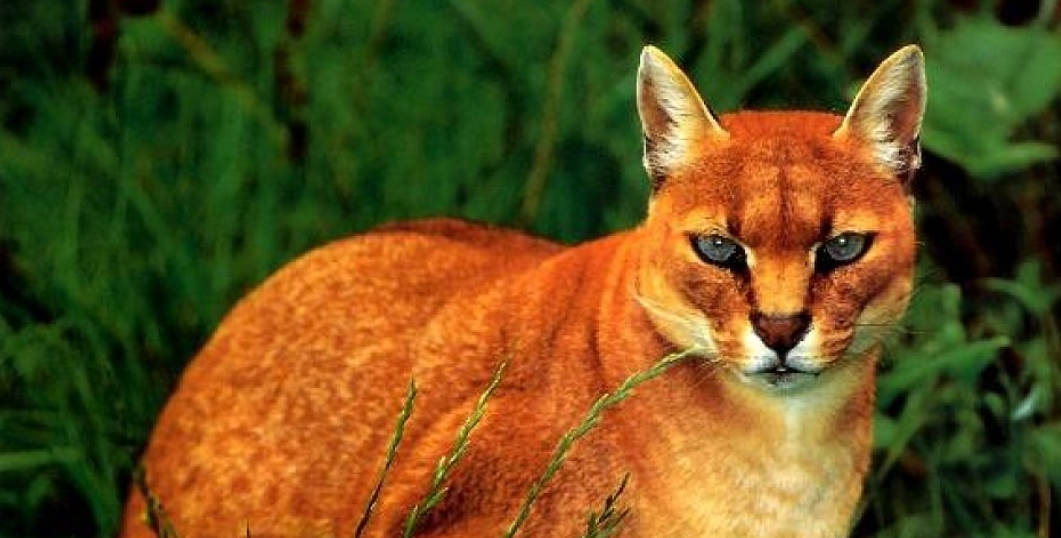
Unique characteristics and facts about African Golden Cat
Throughout the deep woods of Central and West Africa lives the magnificent African Golden Cat. Reddish-brown to grayish-black is the color spectrum of this medium-sized wild cat’s coat, which gives it an amazing look. It is able to maintain balance while moving through the woods because of its long tail, small legs, and powerful torso.
African Golden Cat’s solitary nature and territorial behavior
The African Golden Cat lives mostly alone, in contrast to many other wild cat species. Studying it is difficult since it is very elusive and seldom observed in the wild. But these cats are thought to be mostly nocturnal, hunting throughout the dark hours. Animals ranging in size from rats to monkeys and duikers are all part of their diet.
Threats to the African Golden Cat’s survival, such as habitat loss and poaching
Numerous dangers exist for the survival of the African Golden Cat. Deforestation reduces the cat’s range and messes with its natural environment, which makes habitat loss a serious problem. Furthermore, because of the cat’s exquisite fur’s great demand, the illicit wildlife trade presents a serious danger. A variety of conservation measures, such as the creation of protected areas and education campaigns on the need to protect their habitat, are being taken to save this rare species. Preservation of the biodiversity of the African woods that are home to the African Golden Cat is essential to the species’ long-term existence.
Fascinating facts about African Golden Cat
Found in the thick woods of Central and West Africa, the African Golden Cat (Caracal aurata) is an enigmatic and beautiful feline species. In contrast to what its name implies, the African Golden Cat has a variety of coat colors, such as reddish-brown, gray, and black. Below are some fascinating facts about the African Golden Cat, an uncommon and little-known species of cat.
1. African Golden Cat’s preferred habitats, such as forests of Central and West Africa
Primarily found in the tropical rainforests of Central and West Africa are African golden cats. It is widely distributed, reaching as far east as Kenya and Uganda and as far west as Nigeria and Cameroon. These very adaptive cats may also be found in bamboo thickets and alpine forests.
2. Physical Characteristics: African Golden Cat’s size, weight, and body structure
The African Golden Cat is a medium-sized feline; females weigh somewhat less than males, who typically weigh between 13 and 26 pounds (6 and 12 kilogrammes). They can keep their balance while going through the woods because of their long tail, small legs, and compact body. Depending on the person and the area they live in, their thick fur might have different colors.
3. Nocturnal Behaviour: Unique behaviours or adaptations it possesses
Because they are generally nocturnal, African Golden Cats are most active at night. Through this behavior, they are able to stay out of the way of bigger predators like lions and leopards. They have vast home ranges that they mark with smell to communicate with other cats. They are solitary creatures.
4. Diet: African Golden Cat’s carnivorous diet, small mammals, birds, and reptiles
Since these cats are carnivores, tiny to medium-sized animals, including rodents, monkeys, and duikers, make up the majority of their diet. It is also known that they feed on amphibians, birds, and reptiles. Because of their exceptional climbing and jumping skills, African Golden Cats are expert hunters that ambush their victims from the treetops.
5. Mysterious Nature: Physical features help it adapt to its environment
African Golden Cats are seldom seen by people because of their elusiveness and the thick jungles they live in. They can blend in with their environment with ease since they are quite good at it. This, together with their nocturnal habits and solitary demeanor, makes them difficult to study and observe in the field.
6. Threats and Conservation: Threats to the African Golden Cat’s survival, such as habitat loss and poaching
The International Union for Conservation of Nature’s (IUCN) Red List now lists the African Golden Cat as “near threatened.”. Deforestation, habitat loss, and fur hunting are all contributing factors to their population decline. To preserve their habitats and increase public awareness of the need to conserve this rare cat species, conservation initiatives are being carried out.
7. Cultural Significance: African Golden Cat’s role in local folklore, traditions, or cultural beliefs
Certain African groups place cultural value on the African Golden Cat. They are connected to spiritual practices and beliefs and are revered in certain areas. Additionally, they are sometimes sought for their body parts, which are thought to have therapeutic qualities.
8. Research and Conservation Efforts: Importance of scientific studies in understanding and conserving this species
Because there is so little knowledge about African Golden Cats, study and conservation activities are essential to understanding and safeguarding this enigmatic species. To create successful conservation plans, scientists are researching their ecology, population dynamics, and behaviour.
The importance of raising awareness and taking action to protect the African Golden Cat
The African Golden Cat is a fascinating and mysterious animal that lives in the woodlands of Central and West Africa. Scientists and wildlife lovers alike are fascinated by this cat species because of its unusual physical traits, nocturnal habit, and secretive nature. We can contribute to ensuring the continued existence of this amazing cat for future generations by spreading awareness and funding conservation initiatives.



